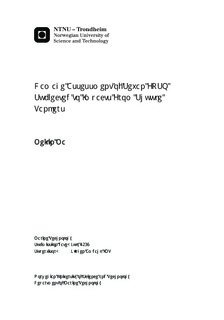| dc.description.abstract | Platform-ship collisions are fortunately rare events, but as the development of the offshore and oil industry and the gradually frequently used offloading operation, accidents become more and more frequent. The consequences of collisions are always severe, which includes loss of life, property and environmental damage. Thus It is important to predict the outcome of collision scenarios and assess the damage that may happen to the platform as well as the shuttle tanker.Collisions are always analyzed by means of the principle of the principle of energy conservation. Initial kinetic energy is dissipated by the two contact bodies as strain energy and in viscous force generation. There is also energy remained as the kinetic energy after the impact for both the striking and struck bodies, both for translational and rotational degrees of freedom. The external mechanics of the collision is easily evaluated, but the strain energy absorption can be rather difficult to evaluate in a correct way.In this thesis, A Samsung shuttle tanker and the Sevan SSP300 platform are analyzed as the striking and struck bodies, respectively. Structural configurations are described for both structures. Different impact scenarios are then discussed in the report, some of which are chosen to analyze in the thesis work. Non Linear Finite Element Analysis (NLFEA) model of the SSP300 platform is created. The shuttle tanker model is an exist one. One-sixth of the platform is modeled in detail with the correct stiffeners and other details, while for the other part, only the outer shell and the main bulkheads are modeled. For the tanker, adjustments are made in order to increase the calculation efficiency. Only the bow is remained in details. For the hull, only the outer shell is remained. For both structural models, adjustments are made to obtain the correct mass, added mass and inertial. Both models have a user defined material with the fracture criterion included. Integrated analysis is mainly performed. Then the integrated analysis is split into internal mechanics and external mechanics. Among these, integrated analysis and internal mechanics analysis are performed with finite element method, using the explicit NLFEA solver LS-DYNA. For the collision scenarios, only bow impact with different headings is considered. Two different impact velocities are chosen in both head on collision and collision with the glancing angle of 30 degrees. Energy absorption and force-displacement relationship can be obtained. Damage on the platform is also evaluated. Internal mechanics are then analyzed by changing the boundary condition and making the impact velocity constant. The purpose is to evaluate the damage with internal mechanics and then compare it with the results from integrated analysis. Liu s method, which is based on Stronge theory, is mainly used in external mechanics as a simplified method. Herein a Matlab program is established to calculate the energy dissipation and the velocity after the impact. Two other simplified methods are utilized to calculate the dissipated energy and then compare them with the results from NLFEA analysis. One is from the DNV-RP-C204 and the other one is from T.de Jonge&L.laukeland s report. The latter one is an optimized method compared to the one from DNV rules, which includes the effect of roll motion. Results from the simplified methods and NLFEA method show good correlation. All the simplified methods overestimate the absorbed energy, which is conservative. Among these, Liu s method gives the best correlation with the NLFEA method. Two additional jobs are conducted in the end. Only the energy dissipation is analyzed in this section. One is changing the loading conditions of the two bodies. The energy dissipation becomes smaller after changing. The other one is changing the friction coefficient. The energy dissipated by the tanker is smaller, while by the platform is larger. But from the overall view, the energy does not show big difference with friction coefficient 0.15 and 0.4. | nb_NO |

